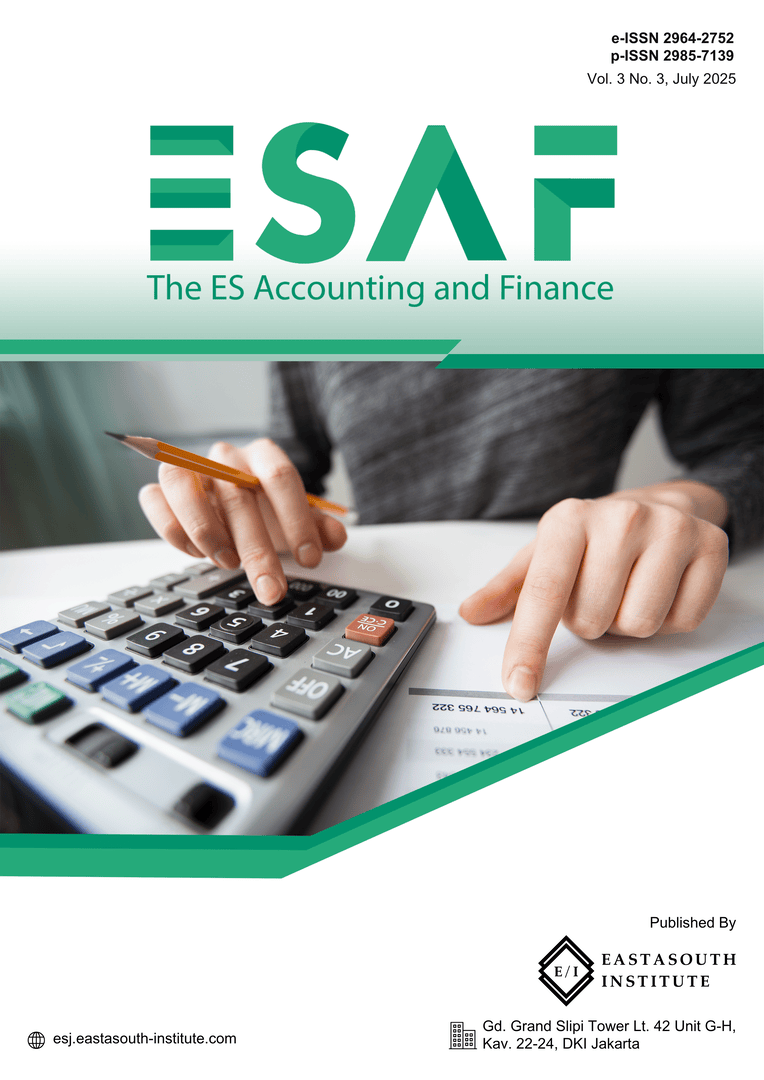Global Trends and Research Evolution of XBRL Adoption in Financial Reporting
Main Article Content
Abstract
This study explores the global trends and intellectual structure of research on XBRL (eXtensible Business Reporting Language) adoption in financial reporting through a comprehensive bibliometric analysis. Utilizing the Scopus database and VOSviewer software, data from 2000 to 2024 were analyzed to identify publication patterns, author collaborations, thematic clusters, and emerging research frontiers. The results indicate that early research predominantly focused on the technical and administrative aspects of XBRL implementation, particularly in the context of financial reporting standardization. Over time, the field has shifted toward evaluating the regulatory, economic, and organizational impacts of XBRL, including its role in reducing information asymmetry, enhancing investor transparency, and aligning with global reporting frameworks such as IFRS. The United States emerged as the leading contributor, while growing scholarly interest is observed in emerging economies like Malaysia and Jordan. Keyword co-occurrence analysis highlights evolving themes and the interdisciplinary nature of the field, suggesting opportunities for deeper theoretical engagement and broader geographic inclusion. This study offers a strategic overview of the development of XBRL research and identifies key directions for future inquiry.
Article Details

This work is licensed under a Creative Commons Attribution-ShareAlike 4.0 International License.
References
J. Efendi, L. M. Smith, and J. Wong, “Longitudinal analysis of voluntary adoption of XBRL on financial reporting,” Int. J. Econ. Account., vol. 2, no. 2, pp. 173–189, 2011.
F. Bartolacci, A. Caputo, A. Fradeani, and M. Soverchia, “Twenty years of XBRL: what we know and where we are going,” Meditari Account. Res., vol. 29, no. 5, pp. 1113–1145, 2021.
C. Liu, “XBRL: a new global paradigm for business financial reporting,” J. Glob. Inf. Manag., vol. 21, no. 3, pp. 60–80, 2013.
R. S. Debreceny et al., “Financial Reporting in XBRL on the SEC’s EDGAR System: A Critique and Evaluation,” J. Inf. Syst., vol. 19, no. 2, pp. 191–210, 2005.
T. Hsieh and J. C. Bedard, “Impact of XBRL on voluntary adopters’ financial reporting quality and cost of equity capital,” J. Emerg. Technol. Account., vol. 15, no. 2, pp. 45–65, 2018.
M. Al-Okaily, H. Boshnak, H. Alkayed, E. Shehadeh, and M. Alqam, “From traditional to digital: the role of XBRL adoption in improving financial statements transparency,” Glob. Knowledge, Mem. Commun., 2024.
M. De Martinis, M. Khedmati, F. Navissi, M. A. Sualihu, and Z. Tofik-Abu, “The role of agency costs in the voluntary adoption of XBRL-based financial reporting,” Int. J. Manag. Financ., vol. 16, no. 5, pp. 599–622, 2020.
H. Borgi, “XBRL technology adoption and consequences: A synthesis of theories and suggestions of future research,” J. Account. Manag. Inf. Syst., vol. 21, no. 2, pp. 220–235, 2022.
R. Debreceny and G. L. Gray, “The production and use of semantically rich accounting reports on the Internet: XML and XBRL,” Int. J. Account. Inf. Syst., vol. 2, no. 1, pp. 47–74, 2001.
N. Donthu, S. Kumar, D. Mukherjee, N. Pandey, and W. M. Lim, “How to conduct a bibliometric analysis: An overview and guidelines,” J. Bus. Res., vol. 133, pp. 285–296, 2021.
N. Van Eck and L. Waltman, “Software survey: VOSviewer, a computer program for bibliometric mapping,” Scientometrics, vol. 84, no. 2, pp. 523–538, 2010.
N. R. Mosteanu and A. Faccia, “Digital systems and new challenges of financial management–FinTech, XBRL, blockchain and cryptocurrencies,” Qual. to Success, vol. 21, no. 174, pp. 159–166, 2020.
H. Yoon, H. Zo, and A. P. Ciganek, “Does XBRL adoption reduce information asymmetry?,” J. Bus. Res., vol. 64, no. 2, pp. 157–163, 2011.
E. Blankespoor, B. P. Miller, and H. D. White, “Initial evidence on the market impact of the XBRL mandate,” Rev. Account. Stud., vol. 19, no. 4, pp. 1468–1503, 2014.
R. Pinsker and S. Li, “Costs and benefits of XBRL adoption: Early evidence,” Commun. ACM, vol. 51, no. 3, pp. 47–50, 2008.
D. Henderson, S. D. Sheetz, and B. S. Trinkle, “The determinants of inter-organizational and internal in-house adoption of XBRL: A structural equation model,” Int. J. Account. Inf. Syst., vol. 13, no. 2, pp. 109–140, 2012.
C. Liu, T. Wang, and L. J. Yao, “XBRL’s impact on analyst forecast behavior: An empirical study,” J. Account. public policy, vol. 33, no. 1, pp. 69–82, 2014.
Y. Dong, O. Z. Li, Y. Lin, and C. Ni, “Does information-processing cost affect firm-specific information acquisition? Evidence from XBRL adoption,” J. Financ. Quant. Anal., vol. 51, no. 2, pp. 435–462, 2016.
E. Bonsón, V. Cortijo, and T. Escobar, “Towards the global adoption of XBRL using International Financial Reporting Standards (IFRS),” Int. J. Account. Inf. Syst., vol. 10, no. 1, pp. 46–60, 2009.
I. Troshani and B. Doolin, “Innovation diffusion: a stakeholder and social network view,” Eur. J. Innov. Manag., vol. 10, no. 2, pp. 176–200, 2007.

